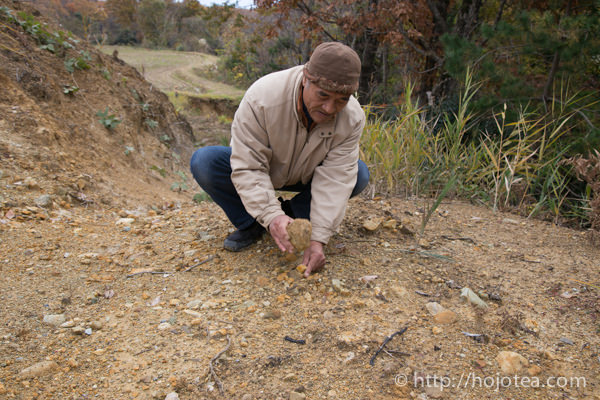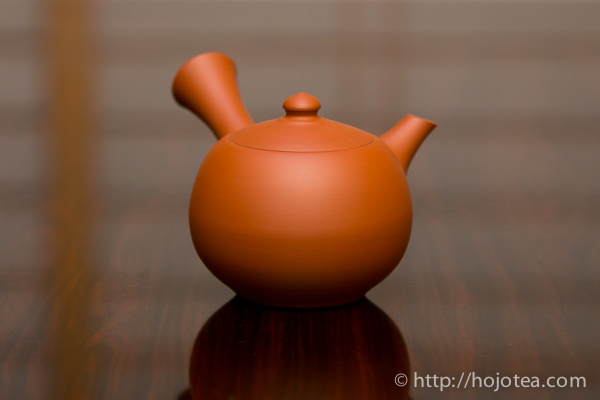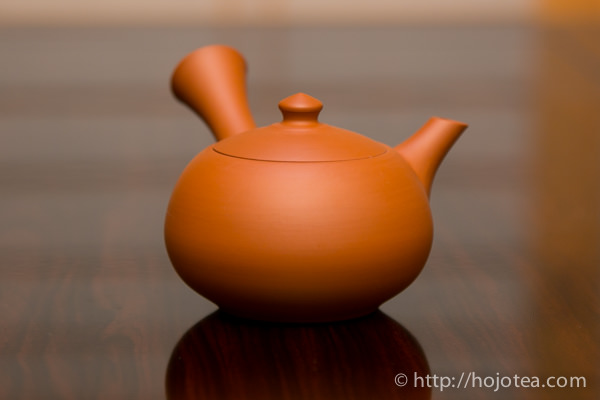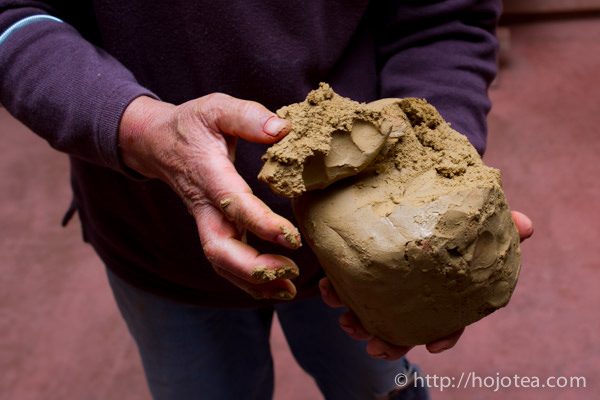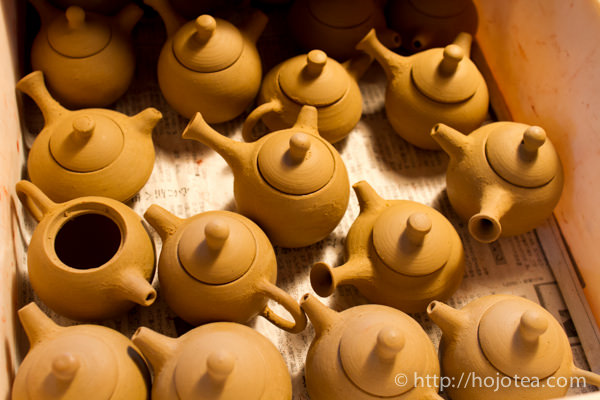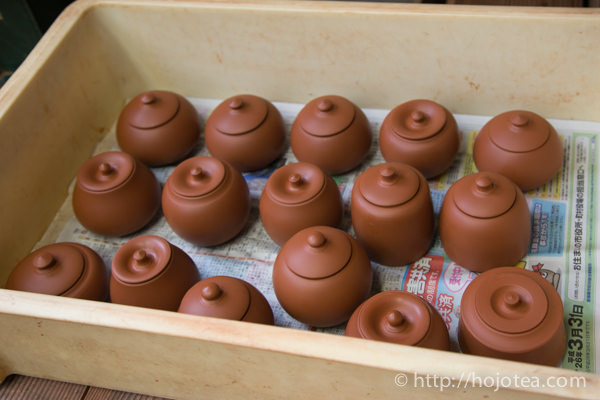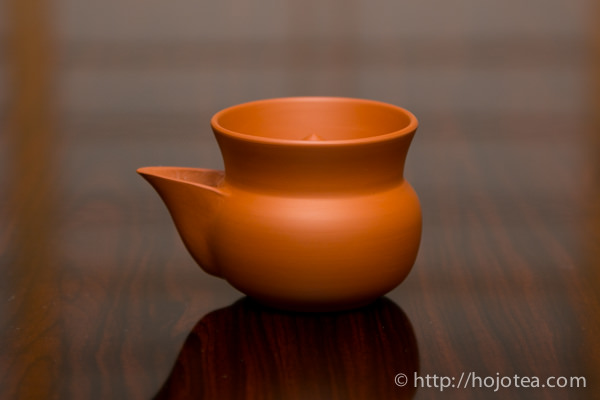- HOME >
- Teapot and Tea Equipment
2 types of clay used for Mumoyi Yaki in Sado Island
In Japan, the pottery in Sado Island that uses natural red clay is called the Mumyoi Yaki (無名異焼). The Mumyoi Yaki is defined as the clay ware made of “Shudei” (朱泥), collected from the Aikawa gold mine and the surrounding mountains. However, if you understand more about the Mumyoi Yaki, you would know that there are 2 types of clays involved. One of the clays is the Nosaka clay that has a yellowish-beige color and it is sticky as it consists of very fine particles, while another type of clay is called the Mumyoi clay which is of orange-red color where the particles are coarser. Both types of clay exist around the Aikawa gold mine area. According to the definition, the clay ware is still known as the Mumyoi Yaki regardless using either one clay or both. Usually, to produce a tea ware of 100% Mumyoi clay is very difficult as it is a little too coarse for the artist to shape. In Japan, majority of artists operate on a potter’s wheel for their work; thus, the clay has to be elastic enough to mold. Hence, it is a common practice to add in a certain percentage of Nosaka clay with the Mumyoi clay to make it malleable enough.
Here is a summary of the Mumyoi Yaki as follow.
- It involves Mumyoi clay and Nosaka clay or either one of 2.
- The artist obtains the clay by themselves and carries out the entire refining process by themselves before it can be molded.
- It resembles the traditions of China Yi Xing teapot production in many ways.
In the quest of clay that improves the taste of tea, we’ve produced teapots using 100% Nosaka Clay and Mumyoi Clay (Mumyoi clay + minor percentage of Nosaka clay). Despite the obvious difference in appearance of these clays (as I’ve mentioned earlier), the color and the appearance of teapot after firing is almost indistinguishable. Thru the history of Mumyoi Yaki in Sado Island, the potters would blend the clays and set a firing temperature only based on the appearance of the tea ware. We, however, discovered that these two types of clay give a completely adverse effect on the taste of water or tea; therefore, we select our own clay based on the effect of taste.
The reason why we introduced 2 types of clay from Sado Island
Nosaka increases the after taste
The Nosaka clay selectively increases the aftertaste of tea but not so much obvious in increasing the body. The tea brewed in Nosaka gives a transparent, clear and smooth image. Moreover, the flavor of tea becomes softer, yet long lasting.
Mumyoi clay increases body
The Mumyoi clay significantly increases the body of tea as well as the after taste. Plus, the flavor of tea brewed using a Mumyoi clay tea ware becomes richer, bolder and wider. This clay performs very well with fermented tea such as Oolong and Black tea. I personally love Taiwanese and Darjeeling tea being brewed in this clay.
Upgrading of the Mumyoi clay
We’ve made some improvement to the Mumyoi clay by analyzing the refining method of clay; by that, we managed to increase the level of the aftertaste and body even more than the previous batch. This is the 3rd successful improvement of this clay in my history.
Related Articles
How to get the latest update on HOJO?
1. Follow Twitter, 2. Click "Like" on Facebook, and 3. Subscribe in newsletter. You can have the latest tea news from HOJO.
 Subscribe the Newsletter to enjoy the privileges
Subscribe the Newsletter to enjoy the privileges- You may receive a free sample upon purchase, or you may have the priority to purchase special products. So please remember to subscribe our newsletter as well as the social network.
- Myanmar White Tea Bud 2013 from Guo Gan, Myanmar
- We have released a raw Pu-erh tea, 緬甸白芽茶 2013 (Myanmar White Tea Bud 2013), produced by ethnic minorities in t …
- Yong De Wild White Tea 2025 Loose Leaf Limited Release
- We have released Yong De Wild White Tea Loose 2025. For the 2025 harvest, only the loose-leaf type was …
NEW ARTICLES
 Myanmar White Tea Bud 2013 from Guo Gan, Myanmar
Myanmar White Tea Bud 2013 from Guo Gan, Myanmar- We have released a raw Pu-erh tea, 緬甸白芽茶 2013 (Myanmar White Tea Bud 2013), produced by ethnic minorities in t …
 Yong De Wild White Tea 2025 Loose Leaf Limited Release
Yong De Wild White Tea 2025 Loose Leaf Limited Release- We have released Yong De Wild White Tea Loose 2025. For the 2025 harvest, only the loose-leaf type was …
 Experience the True Freshness of Raw Pu-erh : Tang Jia 2025 Loose Leaf Release
Experience the True Freshness of Raw Pu-erh : Tang Jia 2025 Loose Leaf Release- We have released Tang Jia Raw Pu-erh Tea 唐家古樹生茶 2025 Loose Leaf. Among HOJO’s raw pu-erh teas, Tang Jia Raw Pu …
 Yunnan Chun Jian Green Tea from High Mountain Gardens
Yunnan Chun Jian Green Tea from High Mountain Gardens- Yunnan Chun Jian Green Tea is now available. This tea is made from naturally grown leaves harvested from high …
 Limited Loose Leaf Release of 2025 Da Xue Shan Wild Raw Pu-erh Tea
Limited Loose Leaf Release of 2025 Da Xue Shan Wild Raw Pu-erh Tea- We have released the 2025 loose-leaf version of Da Xue Shan Wild Raw Pu-erh Tea. This tea comes from wild tea …
 Discover a New Way to Enjoy Tea: Cooking Rice with Tea
Discover a New Way to Enjoy Tea: Cooking Rice with Tea- Cooking rice with tea is a simple idea, but it brings surprisingly satisfying results. The tea’s flavour seeps …
 2025 Da Xue Shan Wild White Tea Now Available from Yunnan
2025 Da Xue Shan Wild White Tea Now Available from Yunnan- The 2025 harvest of Da Xue Shan Wild White Tea is now available. Crafted from truly wild Camellia taliensis tr …
 Fresh 2025 Yunnan White Tea – Select Your Favourite Lot Before Blending
Fresh 2025 Yunnan White Tea – Select Your Favourite Lot Before Blending- Freshly crafted in Yunnan and just arrived in KL, our new 2025 white tea is now available at our Gardens Mall …
 2024 Dong Shan Raw Pu-erh Tea – Crafted with the Producer for Desired Quality
2024 Dong Shan Raw Pu-erh Tea – Crafted with the Producer for Desired Quality- We have released the 2024 cake of Dong Shan Raw Pu-erh Tea. Earlier, we offered the loose-leaf version from th …
 Development of Firewood Roasted Hojicha Using Naturally Grown Tea from Yunnan
Development of Firewood Roasted Hojicha Using Naturally Grown Tea from Yunnan- We are currently staying in Yunnan Province for tea production. As the season nears its end, tea trees with pa …
Category
- New Arrival at HOJO Online Shop
- Featured Articles
- Newsletter
- Types of Tea
- Origin of Tea
- Teapot and Tea Equipment
- Tea Column
- How to enjoy tea
- Tea Processing
- How to choose quality tea
- Tea constituents and functional effect
- Safety of Tea
- Foods
- Tea Business Operation
- Hobby and Outdoor Activity
- Ranking of Tea
- Video
- FAQ
- Media Release
Profile

- AKIRA HOJO
- I invite you to experience my tea selections.I was born in Nagano, Japan. In university, I studied agricultural chemistry, and I have the master degree in food science. I worked in Japanese food industry for 10 years. I involved in R&D, QC and QA. As a factory manager, I implemented ISO9000 series and managed the factory.
- The Art of Tea Magazine
- We posted the article on “The Art of Tea Magazine No.9, the magazine is published in Taiwan. We featured …
- New Straits Times
- The Malaysian National Newspaper, New Straits Times featured HOJO Tea on 17-Oct-2007.
Shop Info

Address:Lot No. T-215, 3rd Floor, The Gardens Mall, Mid Valley City, Lingkaran Syed Putra, 59200 Kuala Lumpur
Tel: +603-2287-4537
Business Hour: 10am to 10pm

